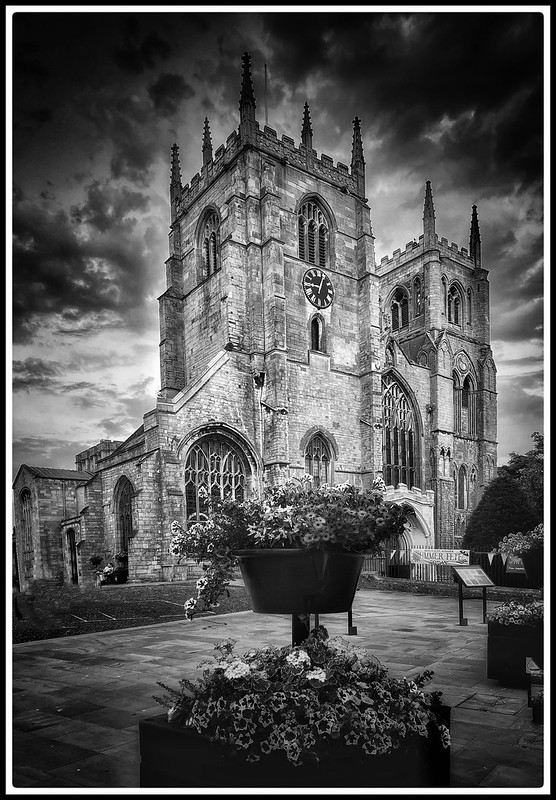Many of the King’s Lynn Guides (who take people on walks around Historic Lynn) will tell you that people are often interested in finding out more about the term ‘minster’. What does it mean? When did St Margaret’s become a minster? Is it a minster because it is such a big church? Does it mean that the church is a cathedral because it is a minster?

Photo © James Rye 2022
King’s Lynn Minster: Historical Importance
The term minster originally applied to communities which dedicated their lives to Christian service and who were bound by a charter. With the systematic introduction of parishes and parish churches it became a title of dignity associated with the collegiate or cathedral churches.
St Margaret’s (St Margaret, St Mary Magdalene and all the Virgin Saints) at Lynn is a large church. It was initially founded by the Bishop of Norwich, Herbert de Losinga, in 1101. It was served originally by Benedictine monks from Norwich Cathedral Priory.

Photo © James Rye 2021
The town of Lynn (originally Bishop’s Lynn) was founded on the bishop’s land between the Millfleet and the Purfleet. As the town expanded it included the land between the Millfleet and the original Fisherfleet.
Two more ecclesiastical buildings were constructed to service the religious needs of the town’s growing population. The town expanded towards what is now The Walks, and St James was started in 1135 by Bishop Everard on the site roughly behind where the nineteenth century London Road Methodist Chapel now stands. (St James ceased being a religious building in 1548 and it collapsed in 1854). And St Nicholas was built from 1146 as the town expanded on the northern side of the Purfleet under Bishop Turbe.
However, it is important to understand that St James and St Nicholas are chapels and not churches. They were called chapels of ease – chapels because they were subservient to the mother church, and of ease because they made it easier for more distant congregations to attend services. Historically, certain religious functions could only be held at St Margaret’s, regardless of a person’s regular place of attendance elsewhere. For example, baptisms didn’t actually happen until 1627. Because certain sacraments attracted fees, this meant that, for around 400 years, the monks of St Margaret’s had some official control and financial dominance over the other religious establishments in the town.
Despite its importance in the town, St Margaret’s did not become a minster until the twenty-first century (see below).
King’s Lynn Minster: Modern Recognition
In modern times minster is an honorific title given to a particular church to recognise its importance in the area. At the time of writing, since 1994, seventeen churches have been designated as minsters.
St Margaret’s Church was made King’s Lynn Minster by the Bishop of Norwich in December 2011 in recognition that it provides a ministry far wider than that of a normal parish church. Apart from the building’s historical and architectural significance the church is the Civic Church for West Norfolk.

Photo © James Rye 2024
What About?
- All Saints’ Church. This church was started in 1095, but it is outside the original town walls and was the Parish Church for South Lynn. South Lynn was not officially incorporated into King’s Lynn until 1555.
- St John’s Church wasn’t built until 1845.
Cathedra: The Chair Questions
- So, is St Margaret’s a cathedral? No. A cathedral houses the cathedra, i.e. the throne which the bishop sits on. A cathedral is the building containing the seat of a bishop.
- So, not all minsters are cathedrals, but are all cathedrals minsters? Yes, because all cathedrals have historic and architectural importance and civic roles. They also have a ministry which is wider than that of a normal parish church. Sometimes their function as a minster is attached to their official name – e.g. York Minster.
- But at this point some of you may be saying: “But, hang on, King’s Lynn has a bishop. So that would make St Margaret’s a minster and a cathedral!” I am grateful to my Anglican friends who have pointed out that the Bishop of Lynn is a suffragen bishop. This means she or he is subordinate to the diocesan bishop. Suffragens are a relatively recent invention, and do not have a cathedra or cathedral. The bishop’s chair (cathedra) for King’s Lynn is in Norwich Cathedral.
© James Rye 2024
Sources
- Personal correspondence with Neil Batcock, Art Historian and retired Anglican Priest.
- https://kingslynnminster.org/minster-story/
- https://english.stackexchange.com/questions/180347/what-is-the-difference-between-a-cathedral-and-a-minster
